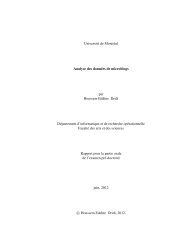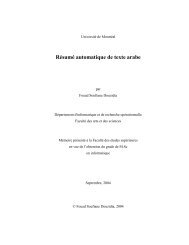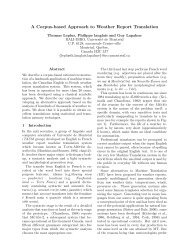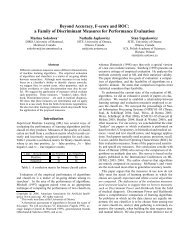Designing a Machine Translation System for Canadian Weather ...
Designing a Machine Translation System for Canadian Weather ...
Designing a Machine Translation System for Canadian Weather ...
You also want an ePaper? Increase the reach of your titles
YUMPU automatically turns print PDFs into web optimized ePapers that Google loves.
<strong>Designing</strong> a <strong>Weather</strong> Warning <strong>Translation</strong> <strong>System</strong> 6<br />
The delay the translation process imposes on the broadcast of warnings becomes<br />
problematic during what meteorologists call “short fuse convective situations”,<br />
weather conditions that typically cause the emission of a large number of<br />
bulletins in a short period. The problem is threefold: (1) the volume of the discussion<br />
text increases, (2) the frequency of bulletins grows and (3) the number of<br />
high-priority translations increases as well. A translation whose priority is high may<br />
concern the imminent <strong>for</strong>mation of a tornado, <strong>for</strong> instance. These problems overwhelm<br />
the translation pipeline, and result in a few bulletins without translations, or<br />
whose discussion is missing altogether. The need <strong>for</strong> swift translations is there<strong>for</strong>e<br />
particularly acute.<br />
Another difficulty lies in the complexity of the current pipeline. Part of the problem<br />
is the fact that ECMT’s output has to go through a separate case- and diacriticrestoration<br />
process further down the pipeline. This creates two distinct processing<br />
steps: one <strong>for</strong> the machine translation, and the other <strong>for</strong> truecasing and accenting,<br />
and there<strong>for</strong>e as many failure points. Furthermore, since the truecasing and accenting<br />
steps are not revised by the <strong>Translation</strong> bureau (contrarily to the translation),<br />
typographical errors are commonly found in warnings published on EC’s website.<br />
One could instead think of a single translation module whose output would be<br />
proper French or English. The translation professionals would then be post-editing<br />
not only the machine translation of the system, but also the post-processing steps,<br />
ensuring a closer revision.<br />
Finally, discussions with EC’s executives suggested that the update and maintenance<br />
of ECMT is difficult in some regards, and that they would welcome a new way<br />
of incorporating feedback from meteorologists and translation professionals into the<br />
translation system.<br />
3.4 WATT <strong>Translation</strong> <strong>System</strong><br />
In light of these needs, the RALI started working in 2009 on a machine translation<br />
system specifically aimed at translating weather warning bulletins issued by EC.<br />
We call this system Watt. Its design is described in this paper. Watt is a fully<br />
automated machine translation component, combining a fuzzy translation memory<br />
and a statistical MT engine. It integrates a truecasing component <strong>for</strong> English and<br />
French and, when it outputs French text, an accenting step as well.<br />
Watt’s architecture is shown in Fig. 3, along with a translation example. This<br />
paper explains in detail the system’s inner workings. We outline them here from<br />
the outset.<br />
1. A source bulletin in MTCN <strong>for</strong>mat is submitted to the system. Word and<br />
sentence segmentation are per<strong>for</strong>med on its discussion.<br />
2. A light rewriting module re<strong>for</strong>mulates and corrects some elements of the input,<br />
<strong>for</strong> instance the <strong>for</strong>mat of dates in English.<br />
3. Serialization is per<strong>for</strong>med, where all numbers and time expressions are folded<br />
into their respective special token, <strong>for</strong> instance TIME <strong>for</strong> time expressions.<br />
4. A sentence-based translation memory made of past translations is queried











